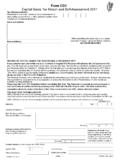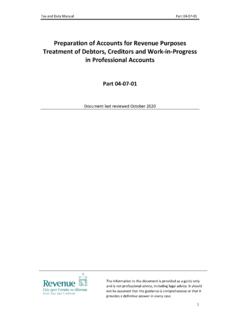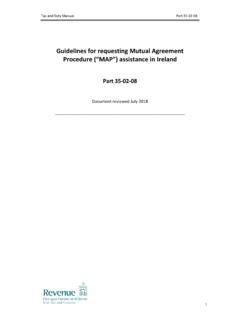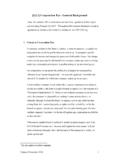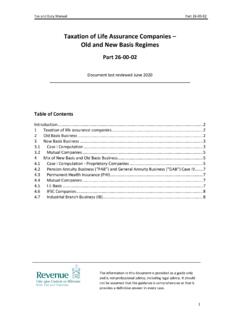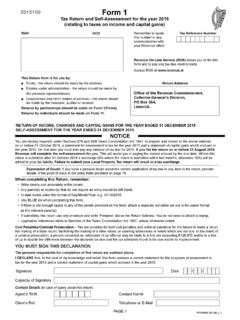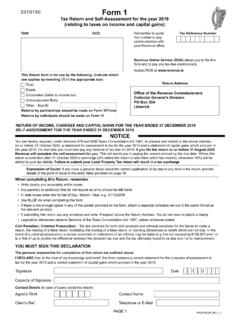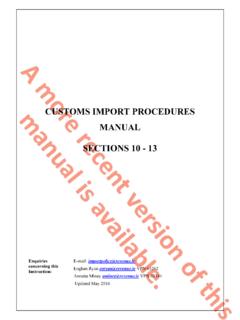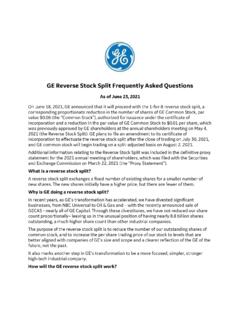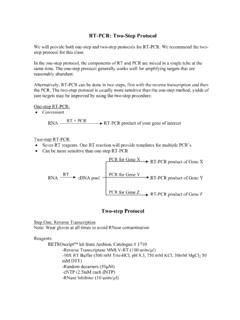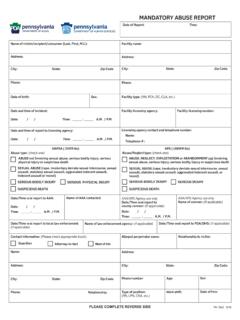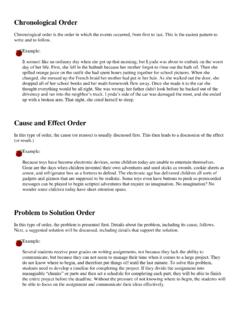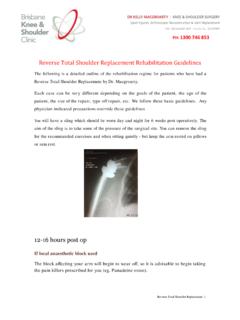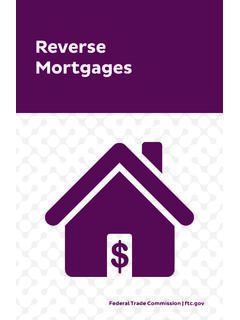Transcription of Reverse Charge Construction - [Reverse Charge Construction]
1 Tax and Duty Manual Reverse Charge Construction Reverse Charge Construction This document should be read in conjunction with sections 16(3) and 66(4) of the VAT Consolidation Act 2010 (VATCA 2010). Document last updated May 2019. Table of Contents 1. How the Reverse Charge operates ..2. 2. Does the Reverse Charge apply to all services?..3. 3. Government departments, local authorities and public bodies ..3. 4. Two-Thirds 5. Supply of goods 6. Sub-contractors established outside the 7. Appendix The information in this document is provided as a guide only and is not professional advice, including legal advice. It should not be assumed that the guidance is comprehensive or that it provides a definitive answer in every case. 1. Tax and Duty Manual Reverse Charge Construction Introduction This guidance sets out the Reverse Charge rules for Principal Contractors and Sub- Contractors involved in the Construction industry where the operation of Relevant Contracts Tax (RCT) is required.
2 The Reverse Charge also applies where there is a supply of Construction work in the State between two connected persons. For further information on the operation of RCT see Revenue information on Relevant Contracts Tax. 1. How the Reverse Charge operates The Charge the sub-contractor makes to a principal contractor does not include VAT. They are not liable to account for or pay the VAT due on the Construction services they supply to a Principal Contractor. Instead the principal contractor calculates the VAT on the amount charged by the sub-contractor and pays the VAT directly to the Revenue Commissioners through his/her VAT return. They are liable to account for and pay the VAT due on the services provided to them by the sub-contractor. The Charge for services by the sub-contractor does not include VAT on the services. The VAT registered sub-contractor issues an invoice to the principal, which shows all the same information as appears on a VAT invoice, except the VAT rate and VAT amount.
3 The invoice should include the VAT registration number of the sub- contractor. The invoice should also contain the statement 'VAT on this supply to be accounted for by the Principal Contractor'. [1]. The principal contractor pays the sub-contractor for the services. This payment should not include VAT. If RCT is to be deducted, it should be calculated on the VAT-exclusive amount. The principal contractor should include the VAT on the services received from the sub-contractor in his/her VAT return for the period in which the supply is made as VAT on Sales (T1). [2]. Where entitled to do so, the principal can claim a simultaneous input credit in his/her VAT return for the period. [3]. [1] If agreed by both the principal contractor and the sub-contractor the principal may issue the invoice. [2] In the case of a payment in advance of completion of the supply, the principal will include the VAT on the payment in his/her VAT return for the period in which the payment is made.
4 2. Tax and Duty Manual Reverse Charge Construction [3] Principal contractor for RCT purposes includes local authorities, Government Departments and boards established by or under statute. Many of these bodies would not be entitled to VAT input credit. See Appendix 1 for examples which illustrate how and when the Reverse Charge is operated. 2. Does the Reverse Charge apply to all services? Generally, VAT on Construction services that are not subject to RCT is taxed under the normal VAT system. A builder who builds an extension for a private individual, or an electrician who installs a new alarm system in a shop should Charge and account for VAT on the supply. The Reverse Charge does not apply to these supplies. The Reverse Charge also applies where there is a supply of Construction work in the State between two connected persons. As many Construction service providers are involved in different types of contracts ( a builder may be acting as principal in one contract, as a sub-contractor in another and supplying services that are not subject to RCT under another contract) it is important to be aware of how the system operates.
5 3. Government departments, local authorities and public bodies Government Departments, local authorities and public bodies who are principal contractors for the purposes of RCT and who receive Construction services must be registered for VAT. They should account for the VAT on services received from sub- contractors directly to Revenue through their VAT return. As these bodies are generally not carrying on any taxable activities they would not normally be entitled to claim any deduction for VAT incurred. See Revenue information on Procurement of goods and services by a public body. Example A County Council contracts for the building of a road with D Ltd which charges 1,000,000 for its services in January/February 2019. For RCT purposes the County Council is a principal contractor and the Construction company is a sub-contractor. 3. Tax and Duty Manual Reverse Charge Construction January/February 2019 VAT Return - County Council VAT 3 Return Example for Reverse Charge VAT 3 Return Example Explanation Amount Headings The Construction company should invoice the County Council for 1,000,000.
6 It does not Charge VAT. T1 VAT on Sale 135, The County Council should calculate the VAT at , 135,000 and show this as VAT on sales (T1) in its January/February 2019 VAT return. T2 VAT on The County Council is not entitled to any VAT deduction, Purchases so it should show VAT on purchases as "Nil". T3 Net Payable The County Council should pay Revenue 135,000 VAT. 135, T4 Net Repayable 4. Two-Thirds rule Where the VAT exclusive cost of goods supplied in the course of providing a service exceeds two-thirds of the total VAT exclusive Charge for the supply, the rate of VAT. applicable is the rate that applies to the goods. The two-thirds rule does not apply where the Reverse Charge applies or where there is a supply of Construction services between two connected persons within the State. 5. Supply of goods only The Reverse Charge will not apply to a supply of goods where that supply is not part of a Construction service that is subject to RCT. 6. Sub-contractors established outside the State A sub-contractor who is established outside the State, and whose only supplies in the State are to principals, is no longer required to be VAT registered in the State.
7 He/she will however need to register for VAT for the purposes of claiming any refund of VAT. A sub-contractor who is established outside the State but who also provides Construction services to customers other than principal contractors must register for VAT irrespective of the level of his/her turnover. 4. Tax and Duty Manual Reverse Charge Construction 7. Appendix 1. The following examples illustrate how and when the Reverse Charge is operated. The services in question are invoiced in January/February 2019. Example 1. A Ltd is renovating a factory building for a manufacturing company. A Ltd invoices the manufacturing company in February 2019 as follows: Construction services 740,740. VAT 100,000. Total 840,740. These services do not come within the Reverse Charge since A Ltd is not a sub- contractor to the manufacturing company for RCT purposes. B, a building contractor, supplies services to A Ltd. A Ltd is the principal contractor and B is the sub-contractor.
8 A Ltd does not hold a deduction authorisation for B. B incurred 13,000 VAT on purchases in January/February 2019 for the purposes of his business. B charges A Ltd 600,000 in January 2019 for the building services. B does not Charge any VAT on this amount. A Ltd accounts for the VAT on the Construction services from B. VAT chargeable on the services at = 81,000. As the Construction services provided by the sub-contractor to the principal were invoiced during January/February 2019 the VAT on these services is accounted for by Reverse Charge in the VAT return for that period. January/February 2019 VAT Return - A Ltd - Principal contractor VAT 3 Return Example for Reverse Charge VAT 3 Return Example Explanation Amount Headings In its January/February 2019 VAT return A Ltd includes T1 VAT on VAT of 181,000 as VAT on Sales ( VAT on its own sales 181, Sale of 100,000 plus Reverse Charge VAT of 81,000 on services received from B). T2 VAT on A Ltd can claim input credit of 81,000 Reverse Charge 81, Purchases VAT in the same return.
9 T3 Net A Ltd should pay Revenue 100,000. 100, Payable T4 Net Repayable 5. Tax and Duty Manual Reverse Charge Construction Revenue will notify the principal as to the rate of RCT to be deducted from the payment to the sub-contractor ( 0%, 20% or 35%). January/February 2019 VAT Return - B, Sub-contractor. VAT 3 Return Example for Reverse Charge VAT 3 Return Example Explanation Amount Headings B does not account for VAT on the services supplied to A. T1 VAT on Sale Ltd as B only does work for a principal contractor and his VAT on sales figure is "Nil". T2 VAT on B is entitled to his input credit of 13,000. 13, Purchases T3 Net Payable T4 Net B is entitled to a repayment of 13,000. 13, Repayable Example 2. The facts are as in Example 1 but B also does building work for private householders in January/February 2019. RCT does not apply to this work. He accounts for VAT of 70,000 in respect of these supplies. C is a sub-contractor, who has his own electrical business, but who does occasional work for B.
10 C's only supplies in this period are made to B. C is registered for VAT. He charges B 48,000. C has incurred VAT of 1,000 for which he is entitled to input credit. B is a principal contractor in respect of the electrical services he receives from C. (For A Ltd see Example 1). January/February 2019 VAT return - B, Building Contractor VAT 3 Return Example for Reverse Charge VAT 3 Return Example Explanation Amount Headings In his January/February 2019 VAT return B included VAT of T1 VAT on 76,480 ( 70,000 VAT charged to private householders 76, Sale plus 6,480 Reverse Charge VAT on services received from C). B does not Charge VAT on supplies to A Ltd, his principal contractor, as A Ltd accounts for VAT on the Reverse T2 VAT on Charge basis. 19, Purchases B can claim VAT of 19,480 ( 13,000 input credit as in Example 1 and 6,480 Reverse Charge on the supplies from 6. Tax and Duty Manual Reverse Charge Construction sub-contractor C). T3 Net B should pay Revenue 57,000.

